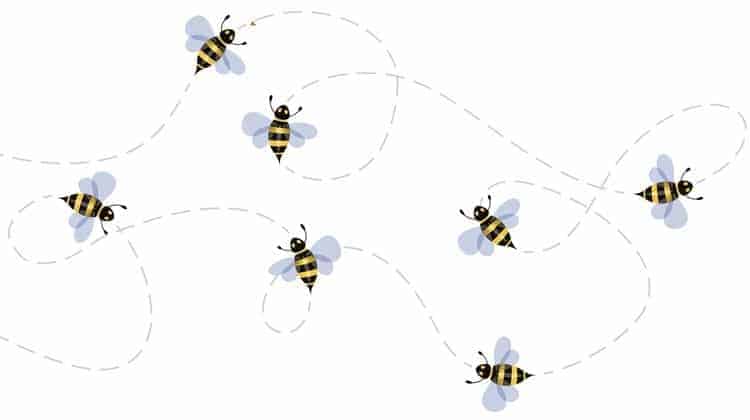“Buzz Marketing” is the process of creating a buzz about a brand, product, or service among a target market’s users or consumers to enhance reach, lead generation, and conversions. We’ll take a deep dive into buzz marketing in this post, learning what it is, different types, and ultimately, examples of buzz marketing words. So, let’s get this started.
What Buzz Marketing?
Buzz marketing is a form of marketing in which businesses rely on consumers to spread words about a product or program through word-of-mouth tactics. So, brands frequently associate buzz marketing with promotions or stunts, encouraging customers to share their opinions about the product with their peers or via social media and hashtags. Another type of buzz marketing is the use of social media influencers to convey their opinions about a product.
How Does Buzz Marketing Work?
Buzz marketing is a sort of word-of-mouth marketing that relies on hype, sales, and a return on investment for a new product while spending very little money. To encourage engagement, companies may offer graphics, GIFs, or other forms of media with a provocative, relevant, or unusual slant. Companies may also hire influencers to act as brand ambassadors, commenting on or sharing online content, combining buzz marketing, social media marketing, and influencer marketing. The interaction creates FOMO, or the fear of missing out, which is crucial in buzz marketing. Others will also want to join in on a meme or viral media piece if there is a lot of interest in it. These viral ads are prioritized on social media platforms, resulting in increased brand recognition.
Types of Buzz Marketing Strategies
Buzz marketing only works if you give them something to talk about. According to Mark Hughes, the genius behind “buzz marketing,” six potential conversion starters, known as “buzz buttons,” indicate the health of a campaign. So, let’s take a look at each of these six choices.
#1. Taboo
Taboo usually relates to contentious topics that aren’t safe or uninteresting, such as politics or vegetarianism. On these matters, everyone has a response or an opinion. Some news networks use scandals to entice people to speak about their programming, which is a form of taboo.
#2. Unusual
The out-of-the-box discussion starter gives your audience something new to talk about. It draws attention to your brand and distinguishes it from the competition. Brands frequently employ “the odd” to introduce a new product to the market and generate buzz about it. It could be something you’ve never seen before or something out of the ordinary.
#3. The remarkable
You tell others when a restaurant goes above and beyond your expectations and provides you with a memorable dining experience, don’t you? Then “the extraordinary” trigger fires. Because it is based on consumer pleasure, it may be the easiest for brands to execute.
#4. Outrageous
The remaining three triggers are more difficult to implement in the workplace.
Consumers are taken aback by outrageous stimuli. Also, several brands use “outrageous” to get people’s attention and increase remember value. The outrageous can be humorous, frightening, sad, or any other feeling.
#5. The hilarious
One of the most popular buzzwords is “hilarious.” It uses comedy to capture and maintain the audience’s attention. Because we’re always looking for reasons to laugh, hilarious content spreads like wildfire.
#6. The secret
The sixth and final buzz button holds the key. People are intrigued by the information that has been concealed from them. They are eager to learn more about a mysterious subject and take satisfaction in divulging information. Furthermore, giving select clients a sneak peek at a product that hasn’t yet been released or behind the scenes at your company is one method to leverage this technique.
Buzz Marketing Words
When planning a digital marketing campaign for your company, it’s critical to be aware of the buzz marketing words that will aid your campaign’s success. These key marketing terms can aid you in the creation and comprehension of your campaign. So, here are today’s top 9 digital buzz marketing words to achieve fluency:
#1. CRM advertising
Customer relationship management, or CRM, is a key component of data-driven marketing. CRM advertising, on the other hand, is a type of data-driven marketing that uses customer data from your CRM to target consumers on social media sites like Facebook and other websites like Google. Data analytics is also used to help in the creation of marketing campaigns.
#2. Marketing automation
Marketing automation is a software platform that helps you generate more leads, turn them into sales, and save money. Customer segmentation, email automation, campaign management, analytics and reporting, and other critical marketing operations are all included. Some systems also include a slew of other functionality, such as landing page builders, blog builders, and social media management tools.
#3. Artificial intelligence (AI).
Artificial intelligence, or AI, is the application of machine learning to software or apps that can perform intelligent tasks. AI is what enables automation and, as a result, leads computers to emulate activities like email generation, data entry, payments and invoicing, and contract management.
#4. Algorithm
An algorithm is a formula that instructs a computer to perform a series of calculations to solve a problem. Google, for example, utilizes algorithms to decide the order in which search results are shown. Do you recall the Hummingbird update? 90 percent of all search traffic was disrupted. Changes to Google’s search algorithm had a direct impact on how brands were discovered and how they generated revenue online.
#5. CTA (Call-to-action)
The CTA (call-to-action), is an extremely effective marketing tactic. It gives your target audience clear directions on how to execute the required action. “Download Here,” “Click Here to Learn More,” “Subscribe to Our YouTube Channel,” and other CTAs are examples. The CTA is commonly denoted by a single button on a landing page, an email campaign, a banner ad, or elsewhere, and is offset by placement, size, and color scheme to draw visitors’ attention to the most appropriate location.
#6. KPI
The KPI, or Key Performance Indicator, is a measurable figure that keeps your plan on track by indicating how well your audience participates in various activities. KPIs assist firms in managing, controlling, and achieving their objectives. Furthermore, KPIs can track anything from total customers to market share percentage to net promoter score and the time it takes for your customer service team to address an issue.
#7. Omni-Channel
Omni-channel marketing is a strategy that focuses on providing customers with a consistent brand experience regardless of where they are browsing and consuming content. It’s simple to stay top-of-mind when you’re always near your customers. These efforts, if well-executed, result in a tailored customer experience that fosters increased interaction with prospects and consumers.
#8. Gamify
The term “gamify” refers to an online marketing method that incorporates game-like aspects such as point scoring, competition, and game rules to transform mundane jobs into something people want to do rather than something they have to do. It promotes customer involvement with a product or service. Nissan’s Carwings app is a wonderful example of consumers connecting with a brand through gamification. It’s for Leaf owners who want to compare their electric vehicle’s performance to that of others using bronze, silver, and gold criteria.
#9. Micro-Moment
Micro-moments are those times when you need assistance and reach for your phone. It could be looking up movie times, comparing pricing before making an in-store purchase, or looking up a supper recipe. According to Think with Google, 91% of individuals use their mobile devices to look up information while doing something else.
Because they’re vital, all of these digital buzz marketing words have become mainstream. Data and measurement are more important than ever in determining which firms succeed. These terms represent a shift in the importance of data in the lives of marketers.
Buzz Marketing Examples
Companies that create internet videos themed around anything humorous, controversial, odd, or outrageous are examples of buzz marketing. They want to create a stir by doing so, causing people to speak about the video, share it on social media, and increase views on websites like YouTube. Companies will then attempt to profit from the content’s popularity by marketing the product on social media, either by developing a hashtag in the hopes of becoming a “trending topic,” or by pushing customers to download further content to increase customer interaction.
The following are some examples of buzz marketing:
#1. ALS Ice bucket challenge.
In this social media-based movement, an individual poured a container of cold water over their head. The goal of the challenge was to raise awareness about Lou Gehrig’s disease, generally known as amyotrophic lateral sclerosis (ALS). The ALS Association and the ALS Therapy Development Institute received a rush of donations as a result of the campaign.
#2. Dell on campus.
In 2016, we executed a college campus campaign to raise brand awareness. It dispatched brand ambassadors to engage with students and have more in-depth discussions about Dell products. This resulted in more memorable experiences with the company and helped to keep the brand in the minds of a key audience.
#3. Super Bowl commercials.
More than 90 million people tune in to watch the Super Bowl, and the advertisements are always a hit. In 2010, Old Spice, a men’s deodorant and shower product firm, redesigned its advertising campaign to include comical and absurd meme-friendly commercials. Terry Crews was shown shouting and riding a tiger in one commercial.
#4. Wendy’s fast-food chain
Wendy’s has a Twitter account where it often produces edgy content criticizing other brands like McDonald’s. During the promotion of their new 2020 breakfast options, Wendy’s also shuttered its Twitter account, making it only accessible to followers. This tactic attracted more followers by encouraging people to follow the account because of the humor. Wendy’s received over 10,000 follower requests in 36 hours after closing its Twitter account, according to Marketingdive.com in 2020. In 2018, Wendy’s sponsored a campaign in which it invented a character in the video game Fortnight that ran around destroying refrigerators. Also, it was a technique for Wendy’s to show that they never utilize frozen beef.
Tips for a Successful Buzz-Marketing Campaign
Let’s take a look at a few essential examples for executing a successful buzz marketing campaign. –
#1. Use communication to expand your product’s reach.
Your major means of communication while running a buzz marketing campaign is your customers. You should implement a communication plan that focuses on your target consumers and informs them of the enthusiasm surrounding your product or service.
#2. The level of customer satisfaction with your goods should correspond to the viral you built.
When you’re operating a buzz marketing campaign, your product must meet and exceeds your customers’ expectations. When a product’s buzz matches the genuine thing, it helps to boost market presence and trust.
#3. Make a viral video to emphasize your excellence and distinctiveness.
When you debut a product and try to generate buzz around it, you need to make sure that it is either better than your competitors’ or has some unique feature that sets it apart from other items.
#4. Your viral should be focused on your campaign’s virtualization.
When you conduct a buzz marketing campaign, you need to back it up with other effective tools that may help you envision your campaign and expand its reach by reaching out to more receptive areas. To make your buzz marketing viral, you can employ commercials, referral campaigns, social media campaigns, influencer marketing, and other methods.
#5. Use internet platforms to increase viral reach and conversions.
Multiple web channels are recommended by marketing professionals to enhance the results of your buzz marketing strategy. Using internet advertising and marketing strategies to improve your buzz’s conversions can be quite beneficial. Furthermore, to improve the virality of your buzz marketing, you can utilize content marketing, email marketing, internet advertising, social media marketing, and advertising.
#6. Measure the success of your viral marketing with monitoring tools.
As with any other campaign, you must monitor what is happening with your monitoring tools to see if your plan is performing, whether anything needs to be changed, what actions to strengthen, and so on.
What Distinguishes Buzz Marketing from Viral Marketing?
The primary distinction between buzz marketing and viral marketing is how messages get to their intended audience. Viral marketing spreads information to consumers over time, gradually gaining traction. Conversely, buzz marketing blasts messages to a sizable audience all at once.
What Is the Efficacy of Buzz Marketing?
Because buzz marketing is a type of word-of-mouth promotion, it is highly effective. According to marketing firm Nielsen, 92% of customers rely on recommendations from friends or family when choosing a product. This is what? Additionally, it is one of the most economical forms of promotion.
What Do Buzz and Stealth Marketing Mean?
Stealth marketing, commonly referred to as undercover or buzz marketing, is a marketing strategy that advertises a product to consumers covertly. Stealth marketing is viewed by many as dishonest and unethical, and businesses that employ it may face repercussions.
What Do Marketing Ghost Ads Entail?
On the other hand, ghost adverts are those for which you intentionally lose a bid. Since your test and control use the exact same targeting settings as the ghost bids, they provide correct incrementality.
How Does Blind Marketing Work?
Blind ad networks or systems do not let marketers choose the websites where their adverts will appear. Advertisers can choose certain content channels, and the advertisements will appear on hundreds or even thousands of websites that fall under that content category even if they have little control over who will see them.
Conclusion
So, on a concluding note on buzz marketing words and their examples, we can say buzz marketing is a sales approach aimed at building a healthy degree of trust, hype, and loyalty among customers to broaden the reach, optimize lead generation and increase conversions. Businesses and brands all around the world must generate a positive and constructive buzz around their products and services. The examples and advice provided above will undoubtedly assist you in launching a successful buzz marketing campaign.
Buzz Marketing FAQs
How do you buzz in marketing?
- Get to know your target audience.
- Tease your campaign ahead of time.
- Create a brand hashtag
- Provide a compelling reason for your consumers to participate.
- Implement a video marketing strategy.
- Identify the appropriate influencers.
What is the difference between buzz and viral marketing?
The primary distinction between viral and buzz marketing is how communications are delivered to the intended audience. Viral marketing allows communication to reach a large number of individuals over time, gradually creating momentum. Also, buzz marketing, on the other hand, broadcasts messages to a large audience all at once.
What brands use buzz marketing?
Buzz marketing is used by companies ranging from Dunkin’ Donuts and Domino’s Pizza to Unilever and Spotify. Also, when it came to creating its “Pave for Pizza” campaign, Domino’s combined buzz marketing with community marketing.
Is buzz marketing Effective?
Because it is a sort of word-of-mouth promotion, buzz marketing is highly effective. According to Nielsen, when making a marketing decision, 92 percent of customers believe recommendations from friends or family. This is also one of the most cost-effective forms of advertising.
Related Articles
- VIRAL MARKETING: Definition and 10 Best Examples of Viral Marketing Campaigns
- Project Management Software: 31+ Top Best PM Software For Business
- ADVERTISING CAMPAIGN: Definition and Best 20 Campaign Examples and Ideas.
- Best Email Marketing Campaign Examples (+ Detailed Guide)
- Best easy advertising campaign guide (+free strategy)






